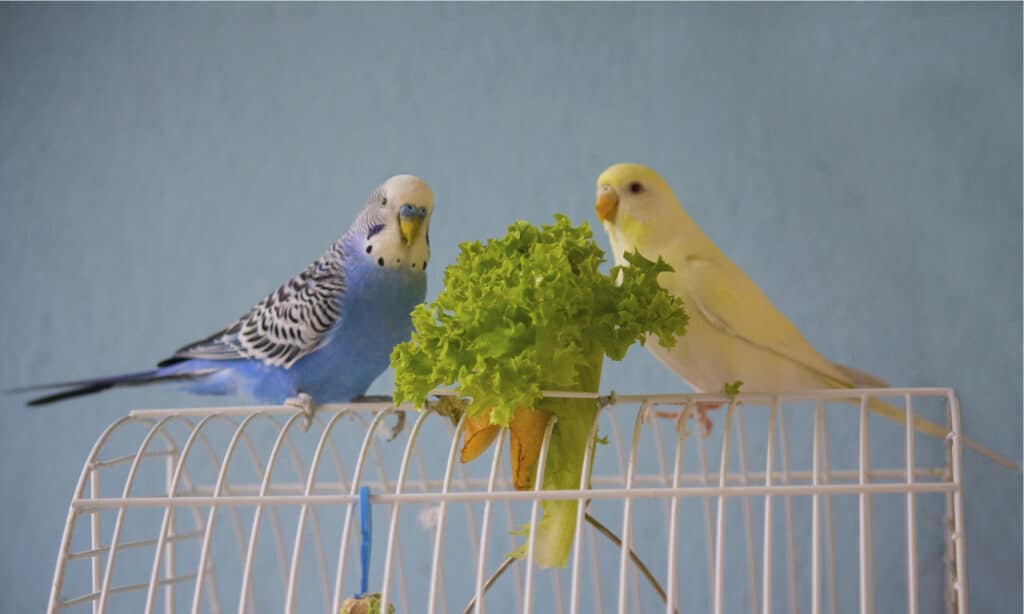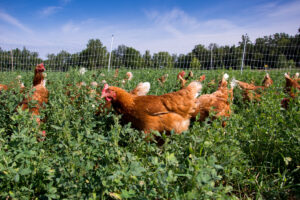Before Buying a Parakeet
It’s always a smart idea to think about the initial and ongoing requirements of owning a pet before taking one on. A pet parakeet is no exception.
The first thing to know about parakeets is they are social birds. So, it’s best to purchase a pair of them from the same pet shop or breeder. Parakeets communicate by chirping, cheeping, and warbling so this is a pet that can be noisy at times.
These birds are sold at a lower price than larger pet birds like cockatiels and parrots. They need a cage of appropriate size and parakeet seed is an ongoing expense. In terms of upkeep, these small birds need to be fed every day and their cage needs to be cleaned once or twice a week.
Parakeets are acrobats. They can climb, swing, and hang upside down. Many parakeet owners enjoy watching their antics either inside the cage or out. These birds can be taught to sit on your finger and eat seed or other treats out of your palm. If treated in a gentle way, parakeets can be affectionate pets!
How Much Does a Parakeet Cost?
At a pet shop, the price of a parakeet is between $30 and $40. Normally, people who specialize in breeding parakeets charge more for their birds. A parakeet from a breeder cost from $100 to $125.
When shopping for a cage to accommodate two parakeets look for one that’s at least 30 inches long, 18 inches wide, and 18 inches tall. In terms of design, there are traditional wire cages available in light or dark colors. If you choose a traditional wire cage, make sure the width between the wires is no more than 0.4 inches. This width prevents a parakeet from getting its head stuck between the bars.
There are more modern cages with sides made of clear plastic. Both types of cages are appropriate for parakeets. Most cages are sold with at least a couple of wooden perches included. Depending on the style of cage you choose, they cost between $130 and $200.
A cage skirt should be purchased with the cage, so you choose a size that fits. A cage skirt fits around the bottom half of the cage. It catches loose seed hulls and feathers keeping them from falling on the floor. It’s a simple item that makes the weekly cleanup a lot faster. A cage skirt is $10.
A cage cover can be bought to fit the exact measurements of your cage. But it’s cheaper to use an old bath towel to cover your parakeets’ cage at night.
Other initial purchases include food bowls, extra perches, and a cuttlebone. For two parakeets, you can opt for two small bowls that hook to the sides of the cage. The total cost for food and water bowls ranges from $3.00 to $7.00.
As mentioned, a couple of wooden perches usually come with a new cage, but parakeets need a variety of them. It’s a good idea to buy one rope style perch as well as a sandpaper perch. Perches of different materials and thicknesses help maintain the health and flexibility of a parakeet’s feet. A sandpaper perch is designed to keep a parakeet’s claws filed down. The cost of two extra perches is $20 to $30.
A cuttlebone hangs on one side of the cage. Parakeets chew or rub on the cuttlebone to remove rough edges from their beak. A cuttlebone is very inexpensive at around $2.00.
Parakeets are active birds and need at least two toys in the cage. Parakeet toys come in so many sizes and designs that it can be hard to choose! Bells on chains, miniature basketball hoops, mirrors, climbing ladders, and swings are just a few toys to consider. The cost of two toys ranges from $10 to $15.
Parakeet seed is an ongoing cost of owning this pet. A five-pound bag costs around $10.00. Of course, if you own more than two parakeets, buying a larger bag of seeds makes more financial sense.
Parakeets need a yearly check-up at the small animal vet. If you have two parakeets, the cost will range from $80 to $100. If a bird needs medication, this adds to the cost.
Parakeets have a life span of five to fifteen years. But, realistically, most parakeets don’t live more than ten years.

Crunching the numbers: The Initial and Ongoing Costs
Initial Costs
- Two parakeets (from a pet shop): $60
- Cage: $130
- Cage skirt $10
- Additional perches: $20
- Food and water bowls: $5
- Cuttlebone: $2
- Food: $10
- Toys $10
Total initial cost: $247
Ongoing Costs:
- Food: (purchased once a month): $10
- Treats:$10 (monthly)
- Yearly veterinary care: $100
Total ongoing cost: $340 (yearly)
Total ongoing cost over ten years: $3400
New Owner Shopping List: What to Buy
When your parakeets come home, it’s best to have everything set up for them so they can start getting used to their new cage right away. This means having a clean cage and the perches in place along with filled bowls.
So, make a plan to go shopping for all of the accessories the day before you get your new birds. Getting all of this ready beforehand makes the transition from pet shop to home less stressful for your new pair of parakeets.
- Cage – Your new parakeets need a place where they have room to move around, stretch, eat, and sleep in security.
- Cage cover – A cage cover is necessary so your parakeets can have a quiet, dark place to sleep at night.
- Cage skirt – A cage skirt attaches to the bottom half of a birdcage. It catches seed hulls, feathers, seeds, and other debris. So, when it’s time to clean, you can dump the contents of the cage skirt into the wastebasket.
- Additional perches – A rope perch, a sand perch, and other types of perches give your parakeets different surfaces to rest on. This helps to keep their feet and claws healthy.
- Food and water bowls – A couple of plastic food and water bowls that attach securely to the side of the cage give your birds the right amount of food and water whenever they need it.
- Cuttlebone – A small cuttlebone attached to the side of the cage helps to keep your parakeets’ beaks trim and even.
- Toys – A couple of toys in the cage can entertain your parakeets while they’re not out exercising or playing with you.
- Food – A five-pound bag of quality parakeet seed can be poured into a plastic container with a lid in order to keep it fresh for your pet birds.
Ongoing Needs: What You Need to Care for Your Parakeet
Food is the most important item on a list of ongoing needs for your parakeets. Treats are another ongoing need for parakeets. If you want to refresh the toys in your parakeets’ cage, you can factor this in as a minor ongoing cost.
- Parakeet food – Parakeet seed should be on your shopping list each month or twice a month depending on the bag size you purchase. Quality seed can be purchased online, in pet shops, or even in the pet aisle at a grocery store.
- Treats – Treats are a fun addition to your parakeets’ diet. Millet spray is a favored treat of many parakeets. A bag of millet spray costs around $5.00 and contains several stalks to hang on the side of the cage.
- Toys – Like most pets, your parakeets are likely to play with one toy more than others. You may want to replace toys on occasion.
How to Introduce Your Parakeet to Its New Home
Not surprisingly, it’s stressful for parakeets to be taken out of a cage at the pet shop, put into a temporary box, then put into an unfamiliar cage at your house. Fortunately, there are some things you can do to help calm your parakeets and make them feel at home.
After putting your parakeets in their new cage, don’t try to hold them or take them out for 24 hours. This gives them the chance to explore their surroundings and become familiar with all of the noises, lighting, and activity in your household. Trying to hold them right away can cause more stress.
Be sure to put some treats such as millet spray into their cage. Seeing a delicious and familiar treat can help to set your parakeets at ease.
Though you shouldn’t hold them for 24 hours, you can definitely talk to your parakeets. Speak to them in an even, soothing tone to help them stay calm and know they are going to be safe in their new home.
Exercise and Ongoing Care
Like other birds, parakeets need to stretch their legs and their wings. Cleaning the cage is another ongoing task of a parakeet owner.
Exercise Routine
It’s a good idea to allow your parakeets time outside the cage for 30 minutes to an hour every other day. This gives them the chance to spread their wings and fly.
Allow them to fly in a softly lit room away from dogs, cats, and other pets. If you have windows, pull the curtains closed to keep the birds from flying into them.
Be sure to leave the door of the birdcage open. Parakeets need to know they can go back into their cage at any time during their exercise period. In fact, many parakeets climb back into their cage when they get tired!
Cleaning the Cage
You can leave your parakeets in the cage while cleaning it once per week. There is a removable tray in most bird cages that you pull out to clean. This tray can be lined with old newspapers. Remove the old newspaper and wash the tray with mild soap and hot water. After drying the tray, put a fresh newspaper lining on the bottom.
Spray a paper towel with a mixture of warm water and white vinegar. Use this paper towel to wipe the poop and other mess off the perches in the cage. Take a moment to wipe down their toys as well.
Remove the water and food bowls to wash them with warm water and mild soap. Then, refill them with food and water.
Empty the cage skirt and vacuum the loose seed on the floor.
Feeding Your Parakeet
It’s best to change and refill your parakeets’ food and water bowls once each day. These little birds eat small amounts of food throughout the day.
Dump the used seed hulls into a trash can and refill the bowl with parakeet seed. Be sure they have fresh water available to them, too.
Parakeets need fruits and vegetables in their diet to stay healthy. So, put a few spinach, lettuce, or celery leaves in the cage along with an orange or apple slice to round out their meal.
RELATED: What Do Parakeets Eat? 5+ Foods In Their Diet

How Long Will Your Parakeet Live?
The lifespan of a parakeet is 5-15 years. But most of them don’t live to ten years old because these birds are especially susceptible to respiratory ailments.
However, the best course of action is to plan on having your parakeet for ten years. That way, you’re ready for a pet requiring a long-term commitment.
RELATED: Parakeet Lifespan: How Long Do Parakeets Live?
Common Health Issues for Parakeets
The most common health issue of a parakeet is a fungus called aspergillosis. This is a respiratory ailment. It can also cause weight loss and listlessness. A bird that’s having difficulty breathing may bob its tail up and down with effort. It’s necessary to take your parakeet to the veterinarian if you see these symptoms.
Where to Buy Your Parakeet
You can buy parakeets at a pet shop or from a parakeet breeder. Both places will have a box or other container for the birds to travel to your home.
Pet Shop Parakeets vs Parakeets from Breeders
When deciding whether to buy a parakeet from a pet shop or breeder, it’s best to note some differences.
For one, most parakeet breeders charge more for their birds than pet shops. Why? Because breeders usually hand-tame their parakeets and take special care when breeding them. Alternatively, most parakeets purchased in pet shops are not hand-tamed and were likely bought in bulk from a supplier.
Unfortunately, many parakeets sold in pet shops are not in excellent health. An unhealthy parakeet has fluffed out feathers and looks listless and dull-eyed.
So, if you want more peace of mind about the health of your new parakeets, it’s worth paying the higher price at a breeder.
Special Considerations with Parakeets
Keeping a pair of these social birds is better than getting just one. But, unless you want to have baby parakeets, be sure you have two of the same sex. In terms of compatibility, two males are likely to get along better than two females.
In addition, make it a point to buy two parakeets from the same cage or family. That way, you know they are already familiar with each other.
Parakeets: Pet Owner Guide, What To Know FAQs (Frequently Asked Questions)
How do I go about buying a parakeet?
First, decide whether you want to buy from a breeder or a pet shop. Next, get all of your supplies ready for your new birds. Then, go pick out either two males or two females with bright eyes, smooth feathers, and plenty of energy.
What is a good price to buy a parakeet?
A good price for a parakeet is $30-$40 each. This is the pet shop price. As a note, if you decide to buy from a pet shop be sure to take a close look at the birds to ensure they are healthy.
What is the safest way to buy a parakeet?
Parakeet breeders are in the business of breeding and raising healthy parakeets, so they are the safest option. Alternatively, a pet shop has many different animals and supplies for sale.
Is it okay to buy one parakeet?
Yes, but that means it will need even more attention from you. Buying a pair of parakeets is a better idea for these social birds.
Is it hard to take care of a parakeet?
No, but they do require regular care and exercise.
Where is the best place to put a parakeet cage?
Put the cage in an area without drafts and near a window so the birds can get a little sunlight.
Do parakeets like being held?
Yes, they can easily be taught to sit on your finger.
How do I keep my parakeet happy?
Talking to your parakeet, giving it treats, and allowing it to exercise regularly are all requirements for making your parakeet happy!
Thank you for reading! Have some feedback for us? Contact the AZ Animals editorial team.




